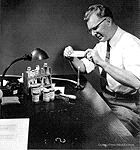Inkjet & Digital Printing
From One Copy to Trillions, Xerography Turns 70

Wednesday 22. October 2008 - Happy birthday to xerography. The invention(PDF, 1.6MB) that made it possible for people the world over to create and share information with trillions of copies and laser prints will be 70 years old tomorrow.
The first xerographic copy was made on Oct. 22, 1938, in a makeshift laboratory behind a beauty parlor in Astoria, Queens, a borough in New York City. The copy, preserved in the Smithsonian Institution, reads “10-22-38 ASTORIA.” The inventor, Chester Carlson, was a scientist and patent attorney who was determined to find a simple way to make copies of documents.
Were he still alive, Carlson might well be surprised to learn his invention uncorked an information revolution that has continued to this day, making information readily available and expanding the world’s total knowledge. Infotrends, an independent industry consultancy, estimates that 3.08 trillion copies and prints were made around the world this year on products fathered by Carlson’s invention.
“Effective use of information is at the core of today’s global businesses, and Chester Carlson’s invention burst the dam that kept information from those who needed it,” said Sophie Vandebroek, Xerox’s Chief Technology Officer and president of the Xerox Innovation Group. “Since then the opportunity to gain knowledge has grown enormously with 281 exabytes of information created and shared in 2007 alone. Today Xerox has a suite of software technologies and services that tame this huge volume of information and help individuals and businesses cut through the clutter, gain knowledge, and make quick and successful business decisions.”
Rejecting photographic methods, Carlson experimented with electrostatic charges and materials that were photoconductive – their electrical properties change when exposed to light. The process he invented was called xerography, taking its name from the Greek words xeros for “dry” and graphein for “writing.” It took another two decades and a bet-the-company investment by a small Upstate New York company named Haloid, which later became Xerox Corporation (NYSE: XRX), to commercialize the process.
Since then information in any form has exploded, and the same company that launched the “sharing” era, now helps customers navigate the flood of information.
Xerox has kept pace with innovations that help clear the path between paper and digital content, cut through the clutter and make information relevant again.
Xerox consistently creates value with its inventions by embedding them in Xerox products, solutions and services, by using them as the foundation for new businesses, and by licensing or selling them to other entities. In 2007, the company worldwide earned 584 U.S. utility patents, a 5 percent increase over 2006.
